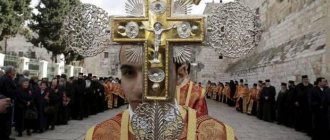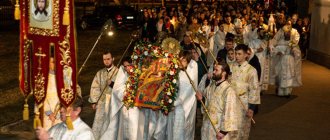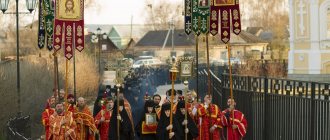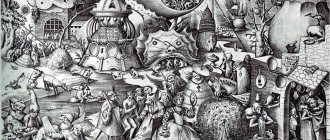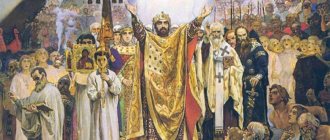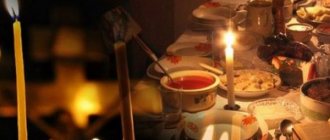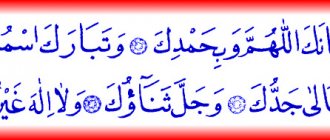The procession of the cross is one of the most iconic and solemn forms of worship. It can be held on Easter or at any other time when believers need the power of common prayer. Such processions are organized both on holidays for Christians and in times of difficult trials. Today, such services accompany all significant events in the lives of believers.
What is the meaning of the procession
In practice, the Procession of the Cross is a journey on foot (sometimes using transport) of a large number of believers and clergy. During the march, people do not just mindlessly walk towards some goal, but pray and carry icons.
Procession of the Cross - a reverent procession of believers with icons and crosses
Symbolically, such a journey means the passage of a person’s life path. And you can just go somewhere, or you can go with prayer and have the Lord as your ultimate goal. In the Procession of the Cross there is a clear reflection on the meaning of human life. Where are we going? What will we find at the end of our journey?
Common prayer greatly unites people, so the formation of an Orthodox community can be called an important goal of the Procession. Unfortunately, in modern churches, especially in big cities, there may not be a church community as such.
People come, defend the service in the temple, light candles and go home. Parishioners of the same church may not know each other for years. And when people are going on a long journey, they have a wonderful opportunity to get to know their brothers in faith.
Important! The religious procession always takes place with icons, banners, and some kind of Orthodox shrines, which are carried at the very beginning of the columns of people.
Prayers and glorifications of the Lord do not cease all the way. The route can be chosen in a variety of ways, for example:
- You can go to churches or monasteries for services in a procession of the cross.
- On days of veneration of Orthodox icons, people can walk around settlements with these images.
- Sometimes moves are organized in territory that is known for tragic events.
- Any other routes of significance from an Orthodox point of view.
The main goal of the procession is the formation of the Orthodox community
The length of the route can be very different - from going around one temple to traveling to another city. What matters is not the duration of the move, but the prayerful mood of the believers, their petitions to the Lord.
Material for production
What is a banner, and what is it made of? For its production, expensive fabrics such as silk, velvet, taffeta, and twill are used. They are trimmed with silver and gold cords in the form of fringes or tassels. Using a special appliqué technique, images of the Virgin Mary, Jesus Christ, and the Trinity are applied to these banners. They also often depict the most revered Saints. Banners made of brocade and velvet are embroidered with gold threads. In some cases, they are made of metals and decorated with decorations made of gold, silver, enamel and enamel.
The pole for the banner is long wooden poles connected in the form of a cross. Some large banners are made with special devices so that 4 people can carry them at the same time. In the central part of the banner there is often an embroidered icon made using the technique of face stitching.
About the revival of religious processions
In modern Russia, the tradition of religious processions is just being revived. The decades of godlessness that our country experienced could not but leave an imprint on the spiritual and church life of society. For many years there were practically no religious processions, despite the fact that this is a very ancient tradition and was very widespread in Tsarist Russia before the revolution.
It is noteworthy that in those days people from all segments of the population took part in such moves - ordinary peasants, nobles, and clergy. Everyone is equal before God, and our people understood this. Very often, religious processions were organized in difficult times for the people. With prayer they went to St. Sergius of Radonezh, to the Solovetsky saints.
The most famous and numerous religious procession - Velikoretsky - managed to survive even during the years of persecution. At that time, very few people took part in it; they were detained and interrogated. Now this is one of the longest, most difficult journeys, which is known throughout Russia and has thousands of participants every year.
The Velikoretsk religious procession is held every year from June 3 to June 8
The history of the origin of the concept itself is interesting. Without realizing it, the first religious procession was performed by Emperor Constantine the Great. One day he had a vision in heaven, in which he was able to discern the outlines of the Cross with the words “By this victory.”
The inspired ruler gave the order to put images of crosses on the shields and military banners of his army, and that’s how he went to battle with the enemy. This is where the tradition of carrying banners in front of a column of people came from.
Birth of a tradition
Processions of the cross are a tradition that came to us from the first centuries of Christianity. However, during the times of persecution of followers of the evangelical teaching, they were associated with considerable risk, and therefore were carried out in secret, and almost no information about them has been preserved. Only a few drawings on the walls of the catacombs are known.
The earliest mention of such a ritual dates back to the 4th century, when the first Christian emperor Constantine I the Great, before the decisive battle, saw in the sky the sign of the cross and the inscription: “By this victory.” Having ordered the production of banners and shields with the image of a cross, which became the prototype of future banners, he moved a column of his troops towards the enemy.
Further, the chronicles report that a century later, Bishop Porfiry of Gaza, before erecting another Christian temple on the site of a ruined pagan temple, made a religious procession to it to consecrate the land desecrated by idolaters.
What types of religious processions are there?
A prayer procession can be timed to coincide with a certain important date, a major holiday (for example, they are often organized on Easter). To consecrate some land, human settlements can also organize prayer processions.
Routes may also vary. The journey can go from one point to another, or it can close in a circle, as a symbol of infinity and Eternal life. The final path can symbolize the path of Christ to Golgotha or the path of the myrrh-bearing women to the Holy Sepulcher.
Important! In addition to banners, icons and any shrines, the Crucifix is always carried at the beginning of the column. That is why the procession is called the Cross, and such a tradition is supported not only in ours, but also in the Catholic tradition.
Thus, most often religious processions are performed by:
- on significant dates of the church annual circle;
- to consecrate places where any miracles or signs were performed;
- during a funeral;
- in difficult times of trial.
An important function of such a procession has always been missionary activity. When religious processions take place in populated areas, especially villages, residents had the opportunity to join in the common prayer.
Procession of the Cross Sevastopol-Kerch-Smolensk
In the modern world, religious processions are not always performed exclusively on foot. Transport can be used to cover long distances. Nowadays there are special biker processions, when a column of people moves on motorcycles.
If the procession is part of a pilgrimage trip, then part of the path can also be covered by transport. Also now sometimes special trips are organized for children and people with disabilities. Such activities are very important because they allow all segments of the population to be involved in prayer work.
Midnight Office
The festive church service, during which a religious procession takes place, begins on the evening of Holy Saturday at 20:00. Its first part is called the Midnight Office. It is accompanied by sad chants dedicated to the suffering on the cross and the death of the Savior. The priest and deacon perform incense (fumigate with a censer) around the Shroud - a cloth plate with an image of Christ laid in the coffin. Then, with the singing of prayers, they take it to the altar and place it on the Throne, where the Shroud will remain for 40 days until the Feast of the Ascension of the Lord.
Procession for Easter
The Easter holiday stands apart in the liturgical circle. Processions of the cross on the Feast of Holidays are held in almost every church and begin on the evening of Holy Saturday. The beginning of this service is mournful, tragic, filled with sadness about the death of Christ.
The Shroud of the Lord is solemnly transferred to the altar of the temple, where it will remain until the Ascension. Easter Matins begins in the village, during which the festive bell ringing is already heard, heralding the joy of the resurrection of Christ.
The Easter procession is held in every church
In this part of the service, all parishioners leave the church for a festive and majestic procession. It is no longer mournful, but joyful and bright. They walk around the church three times, stopping at the entrance doors, which remain closed until the third circle.
The locked doors of the temple symbolize the stone with which the entrance to the Holy Sepulcher was rolled up. On the third circle, the doors open, symbolically indicating that the stone has been rolled away from the Tomb. Next comes the joyful and bright Easter Matins.
It is interesting that the most complex bell ringing takes place precisely during the Easter Procession. It is called "trezvon". Such a chime cannot be heard often in a church, so on Easter the bells sound very special.
Emperor in hair shirt
It is also known that the last emperor of the united Roman Empire, Theodosius I the Great, used to perform religious processions with his soldiers every time he went on a campaign. These processions, preceded by the emperor, dressed in a hair shirt, always ended near the tombs of the Christian martyrs, where the honorable army prostrated themselves, asking for their intercession before the Heavenly Powers.
In the 6th century, religious processions in churches were finally legalized and became a tradition. They were given such great importance that the Byzantine emperor Justinian I (482-565) issued a special decree according to which it was forbidden for the laity to perform them without the participation of clergy, since the pious ruler saw in this a profanation of the sacred rite.
According to the pagan canon
But then theologians began to think: the creation of the ark still dates back to late biblical times, and God has always existed, therefore, communication with God through processions has also always existed. And they attributed the emergence of the tradition in general to angelic times - to the so-called heavenly worship of angels. In fact, if processions behind priests are characteristic of all pagan peoples in general, that is, the processions themselves were a common occurrence during holidays or disasters, then the Christian tradition is precisely timed to coincide with the Way of the Cross of Jesus to Golgotha. It is for this reason that in all Christian denominations the procession is led by clergy with a large cross - a similarity to the one on Calvary. In any case, in the early Christian church religious processions were held precisely on Easter, and probably only inside churches, since walking through the streets with Christian chants in imperial Rome was tantamount to suicide. At the head of such intra-church processions they did not yet wear a large cross, but simply held burning candles in their hands. The state practice of walking with a cross was introduced, according to legend, by Emperor Constantine, who before the Battle of the Milvian Bridge ordered the soldiers to carry banners with crosses made from improvised material, and the few priests accompanying the army to sing psalms and prayers. Whether this actually happened is unknown. But under Constantine, Christianity became the state religion, and each state religion acquires rules - how, where and to whom to pray.
Easter in secular culture
8.1. Russian culture
- In the works of F. M. Dostoevsky, the motif of the resurrection of Lazarus plays a large role (for example, “The Brothers Karamazov”). The author reveals the theme of resurrection from the contrary - through the theme of decay, as a revelation of the categorical - either Christ is risen or life is meaningless (cf. the temptation of monks by the stench from the body of Elder Zosima, the musty bathhouse like Svidrigailov’s hell, Smerdyakov as the main negative character). Prince Myshkin in the novel “The Idiot,” looking at Holbein’s painting “Dead Christ” in Rogozhin’s house, exclaims: “Yes, from this picture someone else’s faith may disappear!”
In The Brothers Karamazov, Elder Zosima talks about the internal renewal of his elder brother at Easter:
Hearing this, he got angry and cursed at the temple of God, but thought about it: he immediately guessed that he was dangerously ill and that this was why his mother was sending him, while he had the strength, to speak and receive communion. ... Three days passed, and Holy Week arrived. And so the brother went to fast on Tuesday morning. ... But he didn’t go to church for long, he fell ill, so they confessed and gave him communion at home. The days came bright, clear, fragrant, Easter was late. I remember he coughs all night, sleeps poorly, and in the morning he always gets dressed and tries to sit in the soft chairs. That’s how I remember him: sitting quietly, meekly, smiling, sick himself, and with a cheerful, joyful face. He changed completely mentally - such a wonderful change suddenly began in him! ... He died in the third week after Easter, in memory, and although he had already stopped speaking, he did not change until his very last hour: he looks joyfully, there is joy in his eyes, he looks for us with his eyes, smiles at us, calls us.
- I. Shmelev in the story “The Summer of the Lord” clearly shows the boy’s perception of the Easter holiday:
B. Kustodiev Easter card (1912)
- Christ is risen from the dead... - Well, Christ is risen... - joyful, dear Gorkin bends down to me. He kisses us three times and leads us to church. It smells sacred of hot wax and juniper. ...death death... to the right!.. The ringing at dawn is incessant. The morning is in the sun and ringing. Easter, red...I look at the eggs given to me. ... And here, porcelain, my father’s. It has a wonderful panorama. Behind the pink and blue immortelle flowers and moss, behind a piece of glass in a blue rim, a picture is seen in the depths: a snow-white Christ with a banner has risen from the Tomb. My nanny told me that if you look behind the glass for a long, long time, you will see a living angel. Tired of strict days, of bright lights and ringing sounds, I peer through the glass. It dies in my eyes, and it seems to me, in the flowers, alive, inexplicably joyful, holy... - God?.. It’s beyond words. I press the testicle to my chest, and a soporific chime rocks me in my sleep. “It’s a late Easter for us, with starlings,” Gorkin tells me, “we’ve just planned something for the guests with you.” Do you hear how it whines?
- The main characters of the stories of Russian writers in everyday life are obliged to deal with people in accordance with their social status, while on Easter they try to treat their neighbors at least once a year in a Christian way.
- Tell me, Mr. Policeman, what day is it today? - I should have been silent! - Bargamot answered contemptuously. - I got drunk until the daylight. — Did they call Michael the Archangel? - They called. What do you care? - Christ, then, has risen? - Well, he's risen. - So allow me... - Garaska, who was conducting this conversation half-turned towards Bargamot, resolutely turned to face him... then fell face down on the ground and howled like women howling for a dead man... - Yai-ch-ko... I... in a noble way... to christ... testicle and you... - Garaska seethed incoherently, but Bargamot understood. This, therefore, is what Garaska was leading to: he wanted to celebrate Christ, according to Christian custom, with an egg, and he, Bargamot, wanted to send him to the police station. ... Bargamot, in a voice that did not leave the slightest doubt about the firmness of his decision, declared: “Let’s go to me to break the fast.” - So I went to you, pot-bellied devil! - Let's go, I say! Garaska's amazement knew no bounds.
- L. Andreev. "Bargamot and Garaska"
Mitka also has his hair combed and dressed in a festive manner. I look cheerfully at his protruding ears and, to show that I have nothing against him, I tell him: “You are beautiful today, and if your hair didn’t stick out and if you weren’t so poorly dressed, then everyone would think that your mother is not a laundress, but a noble one. Come to me on Easter, we'll play grandmas. Mitka looks at me incredulously and threatens me with his hollow fist.
- A.P. Chekhov. "During Holy Week"
As soon as I hear that the dismissal bell will ring and people from the church will leave, I will say hello and say: “Guys! Christ is Risen!" and I will offer them this treat of mine. ... by the clock I realized that the time for the church service would certainly end soon... I got up to go around the posts, and suddenly I heard noise... they were fighting. … What's happened? Who's hitting me? And the main thing is that it’s dark. - The Cossacks, your honor, the vineyards have fallen off!.. they are fighting. ... I must kill him, this Cossack!.. cut him down on the spot!.. But I didn’t cut him down. Now where am I good for? ... And in the depths someone says: “Thou shalt not kill!” I figured out who! “This is what God says: for this, in my soul, a certificate appeared.” This, you know, is a strong, undeniable proof that you don’t need to prove it and you can’t turn it around. God! He is older and taller than Saken himself. Saken will command, and someday he will retire with a star, and God will command the entire universe for centuries! And if he doesn’t allow me to kill the one who beat me, what should I do with him? What to do? Who should I consult with?.. It’s best with someone who has endured this himself. Jesus Christ!.. They beat you yourself?.. They beat you, and you forgave... and what am I in front of you... I’m a worm... disgusting... nonentity! I want to be yours: I forgive you! I’m yours... I just want to cry!.. I cry and cry! People think that I’m doing this out of resentment, but I’m already - you know... I’m not at all out of resentment... The soldiers say: “We’ll kill him!” - What are you saying!.. God be with you!.. You can’t kill a person!
— N. S. Leskov. "Figure"
- Easter is of particular importance in the novel “The Master and Margarita” by M. A. Bulgakov. The action of the novel takes place during Holy Week and ends before the beginning of Easter night, when Woland with his retinue and the main characters leave Moscow -
“- Messire! Saturday. The sun is bowing. It is time". The external series of events of the novel in Moscow is a “parody” of the order of the Orthodox service of Holy Week (cf. Removal of the Shroud and the funeral of the headless Berlioz).[25]
- Easter was reflected in the works of such poets of the Silver Age as S. Yesenin - “Easter Annunciation” (“The dormant bell woke up the fields ...”), K. D. Balmont - “Willows”, I. Severyanin - “Easter in St. Petersburg”.
Russian Easter card with an atypical design (bus) from the 1910s
Russian Easter card with a typical design (Easter eggs) from the 1900s
8.1.1. Easter cards
Since the last third of the 19th century in Russia, it has become traditional to send to those relatives and friends with whom you cannot christen, on Easter as the main holiday, Easter open letters with colorful drawings, the main theme of which was the following: Easter eggs, Easter cakes, Orthodox churches, people christening, Russian landscapes, spring flood, flowers.
Many thousands of different types of Easter cards were published in pre-revolutionary Russia. After the ban in the 1930s, starting from the end of 1941, Easter cards were also published in the USSR and sold in churches. Since the 1970s, postcards began to be published by ordinary publishing houses (Iskusstvo, Planeta, regional) in mass editions (at the same time, for Easter, Easter cakes baked at state bakeries appeared in USSR bakeries).
8.2. Foreign culture
Dinner at Emmaus. Caravaggio, 1603, National Gallery, London
J. S. Bach wrote “Passion according to Matthew”, “according to John” and “according to Mark” (partially) for the Lutheran services of Holy Week, and for Easter “Easter Oratorio”.
The action of I. Goethe's Faust begins on Easter night. The memory of Easter joy turns Faust away from suicide.
Chorus of Angels
Christ is risen!
Overcoming Death and Decay Glory, village, arable land and forest... Faust
I cried, reveling in the happiness of tears, And an unprecedented world was born in me. Since then, everything that is pure and bright has been associated in my soul with bright Sunday. It, with its spring spirit, did not allow me to end myself now. I am returned to the earth. Thanks for this to you, holy hymns!
8.3. Modern culture
- "DDT" Yuri Shevchuk
, "Easter"
“We thought that was it, but it just started to rain... Easter has begun, the bells are ringing, the copper mouth is breathing.”
- In the episode "The Wonderful Easter Story" South Park
Stan is looking for the roots of Easter traditions.
- Computer game developers sometimes hide “Easter eggs” in them - secret rooms, developer jokes, and similar little things.
- "Gaza Strip" Yuri (Khoy) Klinskikh
, "Easter"[26]
Easter, I'll take a three-liter jar out of the cupboard.
Easter, I’ll paint eggs, even though I can’t see it in my trousers...
Celebration of Easter in various countries
Countries where Easter Monday is a public holiday
In most European countries, Holy Week and the week after Easter are school and student holidays. Many European countries, as well as Australia, celebrate Easter and Easter Monday as public holidays. In Australia, the UK, Germany, Canada, Latvia, Portugal, Croatia and most Latin American countries, Good Friday is also a public holiday. The entire Easter Triduum is a public holiday in Spain.
7.1. States where Easter is 4 days off (Friday, Saturday, Sunday, Monday)
- Australia
- Austria
- Bulgaria
- Great Britain
- Hungary
- Ghana
- Germany (On Friday, Sunday, Monday, shops, etc. are closed. On Saturday, shops, banks, etc. are open)
- Greece
- Georgia
- Denmark
- Spain Thursday, Friday, Sunday, Monday in some autonomous regions.
- Italy (Saturday[source not specified 52 days
], Sunday Monday)
- Canada
- Cyprus
- Latvia
- Moldova (Saturday, Sunday, Monday)
- New Zealand
- Norway
- Portugal
- Serbia
- Slovakia
- Slovenia
- Ukraine (Saturday, Sunday, Monday)
- Finland
- Croatia
- Switzerland
- Sweden
Holy Fathers about Easter
Saint Gregory the Theologian
- St. Gregory the Theologian
: “With them, I (oh, if only I had a voice worthy of an angel’s song, and one that announces the ends of the world!) tell you this: Easter!
The Lord's Easter! And I’ll also say in honor of the Trinity: Easter! She is our holiday celebration and celebration of celebrations; so much surpasses all celebrations, not only human and earthly, but even those of Christ and for Christ, as much as the sun surpasses the stars. ...now we celebrate the resurrection itself, not yet expected, but already accomplished and reconciling the whole world. But let us partake of Easter, now in a representative way, although more openly than in the Old Testament. For the legal Passover (I dare say, and I do) was an even more obscure type of foreshadowing. And later and soon we will receive more perfect and purer communion, when the Word will drink with us this “new wine
in the Kingdom of the Father” (Matthew 26:29), revealing and teaching what has now been revealed by Him to some extent; for what is now known is always new. What does this drinking and this eating consist of? - For us it is to learn, and for Him to teach and communicate the word to His disciples; for teaching is food for him who feeds.”[13] - St. Meliton of Sardis
(fig.[19]
Saint Gregory of Nyssa
- St. Gregory of Nyssa
: “Just as a new, newly formed swarm of bees, flying out of the beehouse into the light and air for the first time, all sit together on one branch of a tree, so on a real holiday, all members of families from everywhere gather in their homes.
And it is truly fair to compare the present day with the day of the future resurrection, because both gather people; only then will everyone come together, but now they are gathering in parts. As for joy and joy, in all fairness we can say that the present day is more joyful than the future: then, of necessity, those whose sins will be exposed will cry; Now, on the contrary, there are no sad people among us. Now the righteous man rejoices, and he who has not cleared his conscience hopes to be corrected by repentance. This day eases all sorrow, and there is no person so sad who would not find consolation in the celebration of the holiday. Poor people, accept this day with love as it nourishes you. Weakened and crippled, welcome this day that heals your illnesses. The hope of your resurrection is hidden in it, which prompts you to be zealous for virtue and hate vice; for with the destruction of the thought of the resurrection, everyone will have one dominant thought: “Let us eat and drink, for tomorrow we will die!”
(1 Cor. 15:32).”[20] - St. Leo the Great
: “So, since through forty days of abstinence we wished to achieve, at least to some extent, during the Lord’s suffering, to feel His cross, we must strive to become participants in the resurrection of Christ and, while still in this body, to move from death to life.
After all, for every person who changes and becomes from one to another, the end is not to be what he was, and the beginning is to be what he was not. But it is important for whom a person will die and for whom he will live, because there is death leading to life, and there is life leading to death. And not just somewhere, but in this transitory age one can find both; and the difference in eternal rewards depends on how we act in time. So, you need to die for the devil, and live for God; you need to get rid of injustice in order to rise up for the truth. Let the old fall so that the new may appear. And since, as the Truth says, “no one can serve two masters”
(Matthew 6:24), let him not be master who caused those standing to fall, but He who raised up those who were cast down to glory.”[21] - Blzh. Hesychius of Jerusalem
: “Our sacred and royal trumpet united us in this meeting, a trumpet that filled Bethlehem and set Zion on fire, for which the Cross was the hammer, and the Resurrection the anvil... Joseph buried Him as a dead man, but, buried as a man, He, as God, disarmed death.”[22]
- St. Theodore the Studite
: “Why do we wait so impatiently for Easter, which comes and goes? Haven't we celebrated it many times before? And this one will come and go - in the present age there is nothing permanent, but our days pass like a shadow, and life runs like a messenger gallops. And so on until we reach the end of real life. Well, someone might ask, shouldn’t we rejoice at Easter? - No, on the contrary, let's enjoy it much more - but that Easter that happens every day. What kind of Easter is this? - Cleansing of sins, contrition of heart, tears of vigil, clear conscience, mortification of earthly members: fornication, impurity, passions, evil desires and all other evil. Whoever is worthy to achieve all this celebrates Easter not just once a year, but every day.”[23]
Saint John Chrysostom
- St. John Chrysostom
: “Therefore, all of you, enter into the joy of our Lord;
both the first and the second will receive a reward; rich and poor rejoice one with another; those who are abstinent and careless, honor this day; those who have fasted and those who have not fasted, rejoice now. The meal is plentiful - be satisfied, everyone; the calf is great, let no one go hungry; everyone enjoy the feast of faith; everyone, take advantage of the wealth of goodness. Let no one complain about poverty; for the common kingdom has been opened. Let no one cry for sins; for forgiveness has shined from the grave. Let no one fear death; for the death of the Savior has set us free. He destroyed her, being embraced by her; He emptied hell by descending into hell; grieved the one who touched His flesh. Isaiah, having foreknew this, exclaimed: “Hell
,” he says,
“was upset”
(Is. 14:9).
He was sad because he became idle; I was upset because I was ashamed; he was grieved because he was killed; he was grieved because he was deposed; I was upset because I was tied up. He took the body and found God in it; took the earth and met the sky in it; took what he saw and underwent what he did not see. "Death!
where is your sting? hell! where is your victory?“ (1 Cor. 15:55).
Christ has risen, and you have fallen; Christ rose again, and the demons fell; Christ has risen, and the angels rejoice; Christ has risen, and life is restored; Christ has risen, and there is not one dead in the tomb. For Christ, who rose from the dead, is “the firstborn of those who sleep”
(1 Cor. 15:20). To him be glory and power forever and ever. Amen."[24]
The last word is read every Easter in Orthodox churches after Easter Matins.
